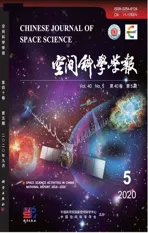Progress Update in Space Cell Mechano-biological Coupling*
2020-01-09LONGMianSUNShujinLINingDongyuanGAOYuxin
LONG Mian SUN Shujin LI Ning LÜ Dongyuan GAO Yuxin
Progress Update in Space Cell Mechano-biological Coupling*
LONG Mian SUN Shujin LI Ning LÜ Dongyuan GAO Yuxin
(100190)
Recent progresses in 2018–2019 from space experiments onboard SJ-10 recoverable satellite and on parabolic flight were summarized, mainly focusing on cell mechano-biological coupling under microgravity. In the meantime, technical pre-research and experimental system design for the biomechanics research platform on China Space Station was carried out and updated.
Microgravity, SJ-10 satellite, Parabolic flight, Endothelial cells, Mesenchymal stem cells, Hepatocytes, Mechanotransduction, China Space Station
In 2018 and 2019, we focused on elucidating the mechano-biological coupling mechanisms of mammalian cells under microgravity and developing the novel techniques for the biomechanics experimental platform on China space station. The progress is updated briefly as follows.
1 Data Analysis and Technical Summary of the Space Experiment Onboard SJ-10 Recoverable Satellite
Data collected from a space experiment on SJ-10 recoverable satellite in 2016 and ground-based control experiments were analyzed, and the performance of the hardware developed for the space experiment was summarized. The results indicated that space microgravity improved the hepatocyte differentiating capability of rat mesenchymal stem cells by up- regulating hepatocyte-specific albumin and cytokeratin 18[1]. Meanwhile, space microgravity suppressed the glucose metabolism, modulated the expression of cellular adhesive molecules such as ICAM-1, VCAM- 1, and CD44, and depressed the pro-angiogenesis and pro-inflammation cytokine secretion in EA.hy926 Endothelial Cells (ECs). Cytoskeletal remodeling, such as depolymerization of actin filaments and microtubules were found in space samples. Three- dimensional cell growth or enhanced nitric oxide production, which was documented in clinostat experiments, was not observed in ECs cultured in space[2]. Experimental techniques used in the space experiment were reviewed, and the performance of an integration design including gas exchange, bubble separation, and flow control was verified, providing a valuable platform for establishing space experimental technical standard[3].
2 Data Analysis of the Experiment on Parabolic Flight in 2017
This study was proposed to characterize how immune cell function is affected by altered gravity produced by Parabolic Flight (PF, 30th DLR parabolic flight, a 4-day mission in September 2017). It applied an integrated biomechanical and biomedical approach with forced fluid flow and on-line cell imaging, allowing to elucidate the rolling and adhering features of Jurkat cells and Peripheral Blood Mononuclear Cells (PBMC) on flow chamber substrate coated with different adhesion molecules. The results indicate that, in contrast to hyper-(1.8) and control conditions (1), the rolling speed of PBMCs was moderately accelerated during µ-periods which were accompanied by a clear reduction in rolling rate. Whole blood analyses revealed a primed state of monocytes after PF with potentiated antigen-induced pro-inflammatory cytokine responses. At the same time, the concentrations of anti-inflammatory cytokines were increased and monocytes displayed a surface molecule pattern that indicated immunosuppression. The results suggested an immunologic counterbalance to avoid disproportionate immune responses[4].
3 Technical Pre-research and Experimental System Design for the Biomechanics Research Platform on China Space Station
A space biomechanics experimental platform on China Space Station is under development for a series of biomechanics studies. This work aimed at quantitatively controlling different mechanical conditions for cell and tissue samples that mimic the mechanical environment inunder microgravity. Techniques for loading modulation of flow shear stress, substrate tension, substrate physical property, and mass transport were tested. In order to obtain data with reliable control design and adequate repeatability, the factors that could affect experimental results were analyzed. The fast handling techniques for sample modules and the on-line automatic ope- rations of medium supply, chemical fixing, and microscopic observation are under optimization. The designed experimental system is expected to provide a normalized platform for elucidating mechano- biological coupling mechanisms during gravity-varied processes.
[1] LÜ Dongyuan, SUN Shujin, ZHANG Fan,Microgravity-induced hepatogenic differentiation of rBMSCs on board SJ-10 satellite [J]., 2019, 33(3):4273-4286
[2] LI Ning, WANG Chengzhi, SUN Shujin,Microgravity- induced alterations of inflammation-related mechanotransduction in endothelial cells on board SJ-10 satellite [J].2018, 9:1025
[3] SUN Shujin, WANG Chengzhi, BI Yuzhen,An integration design of gas exchange, bubble separation and flow control in a space cell culture system on board the SJ-10 satellite [J].2019, 90(7):075114
[4] MOSER D, SUN Shujin, LI Ning,Cells flow and immune cell priming under alternating g-forces in parabolic flight [J]., 2019, 9:11276
V524
LONG Mian, SUN Shujin, LI Ning, LÜ Dongyuan, GAO Yuxin. Progress Update in Space Cell Mechano-biological Coupling., 2020, 40(5): 935-936. DOI:10.11728/cjss2020.05.935
* Supported by Strategic Priority Research Program and Frontier Science Key Project of Chinese Academy of Sciences (XDA04020202-17, XDA04020416, XDA15014100 and QYZDJSSW-JSC018), National Natural Science Foundation of China (U1738115)
March 13, 2020
E-mail: mlong@imech.ac.cn
杂志排行
空间科学学报的其它文章
- Science Research and Utilization Planning of China’s Space Station in Operation Period 2022–2032
- China’s Lunar and Deep Space Exploration Program for the Next Decade (2020–2030)*
- Recent Advances in Research of the Chinese Meridian Project*
- China’s Future Missions for Deep Space Exploration and Exoplanet Space Survey by 2030*
- Progress of Space Medicine Research in China
- Space Materials Science in China: II. Ground-based Researches and Academic Activities*
